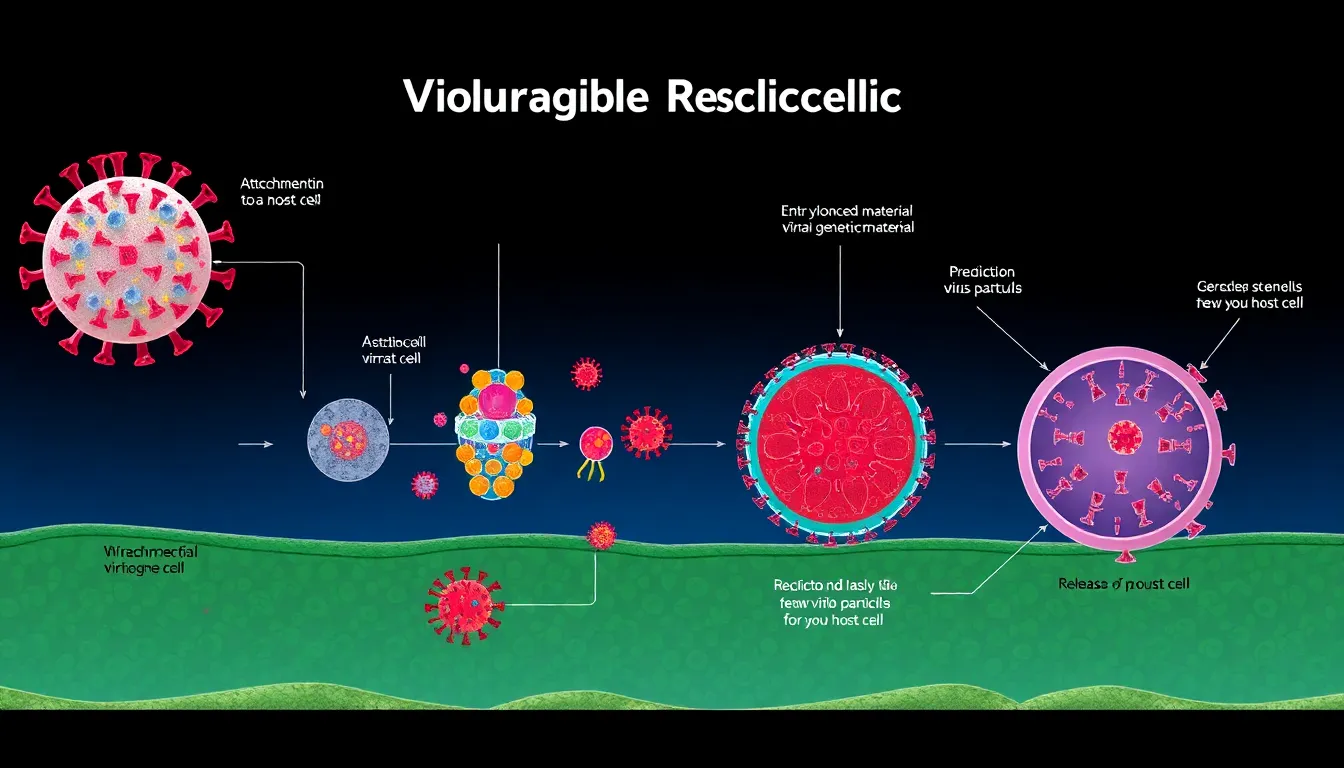Viruses are the ultimate party crashers of the microscopic world. They invade host cells, hijacking their machinery to replicate and spread like a viral meme on social media. Understanding viral replication isn’t just for the science nerds; it’s crucial for everyone who wants to stay healthy in a world where viruses are always looking for a new host.
Table of Contents
ToggleOverview of Viral Replication
Viral replication involves several key stages that enable viruses to proliferate within host organisms. Initially, viruses attach to specific receptors on the surface of host cells. This attachment facilitates the entry of the viral genetic material into the cell.
Once inside, the virus hijacks the cell’s machinery, utilizing it to replicate its genome. Host ribosomes produce viral proteins, allowing the virus to assemble new viral particles. These proteins and replicated genomes then combine to form complete viruses within the host.
After assembly, the newly formed viruses exit the host cell. Most commonly, this occurs through lysis, where the host cell bursts, releasing numerous viral particles into the surrounding environment. Alternatively, some viruses use a process called budding, which allows for a more controlled exit while keeping the host cell alive for further replication.
Viruses can replicate rapidly, reaching thousands of copies in just a few hours, depending on the virus and host. During this process, the replication cycle can lead to mutations, which contribute to viral evolution and adaptability. Understanding these mechanisms is crucial for developing antiviral treatments and vaccines, improving public health strategies, and mitigating outbreaks.
Research continues to highlight the impact of various factors, such as immune responses and antiviral drugs, on the efficiency of viral replication. Studying replication can provide insights into virus behavior and interactions with host defenses, essential for advancing medical interventions.
Stages of Viral Replication

Viral replication consists of several distinct stages. Understanding these stages provides insights into how viruses invade host cells and reproduce.
Attachment
Viruses begin by attaching to specific receptors on the surface of host cells. This attachment is critical for the subsequent entry of viral genetic material. Targeted interactions between viral surfaces and cell receptors determine the virus’s host range. Upon successful attachment, the virus establishes a foothold, preparing for the next phase of infection.
Penetration
Penetration follows attachment, allowing viral genetic material to enter the host cell’s cytoplasm. Various mechanisms facilitate this process, including fusion with the cell membrane and endocytosis. Once inside, the virus sheds its protective coat, releasing its genetic instructions into the host. This step marks a significant turning point, as the virus now has access to the host’s cellular machinery.
Replication and Assembly
Replication begins when the viral genome hijacks the host’s cellular machinery. Viral enzymes utilize the host’s resources to create copies of the viral genome and synthesize viral proteins. New viral components assemble within the host cell, forming immature virus particles. This replication phase can occur rapidly, resulting in the production of numerous viral entities.
Release
Release occurs when newly formed viruses exit the host cell either through lysis or budding. Lysis leads to immediate cell death, while budding allows the host cell to survive momentarily. Released viruses can go on to infect additional cells, perpetuating the viral cycle. This rapid release contributes to the spread of infection throughout the host organism.
Factors Influencing Viral Replication
Viral replication is influenced by various factors, including the types of host cells and environmental conditions in which the viruses operate. Recognizing these elements is essential for understanding how viruses spread and adapt.
Host Cells
Specific host cells provide the necessary environment for viral replication. Variability among cells impacts the efficiency of viral infection. Some viruses target particular cell types, while others can infect multiple cell lines. Receptor availability on cell surfaces plays a crucial role, as this determines which viruses can attach and enter. Furthermore, the intrinsic properties of host cells, such as their metabolic activity and immune responses, significantly influence viral replication rates. A thriving cellular environment promotes rapid viral reproduction, while an infected cell under stress may limit the virus’s growth.
Environmental Conditions
Environmental factors can dramatically affect viral replication. Temperature, humidity, and pH levels influence virus stability and transmission efficiency. High temperatures often reduce viral stability, while low temperatures can preserve viral infectivity. Humidity levels impact aerosol transmission, as dry conditions facilitate faster evaporation of respiratory droplets, potentially increasing infection spread. Acidic or basic conditions can also disrupt viral structure, affecting its ability to replicate effectively. Overall, optimal environmental conditions enable viruses to thrive and maximize their replication potential within host organisms.
Implications of Viral Replication
Understanding viral replication carries significant implications for medicine and public health. The complex process affects how viruses cause diseases and informs strategies to combat viral infections.
Medical Significance
Medical professionals rely on knowledge of viral replication to devise effective treatments. Antiviral drugs target specific stages in the replication cycle. For instance, some medications inhibit viral entry, while others block replication or release. Developing vaccines also depends on understanding how viruses replicate. Effective vaccines stimulate immune responses tailored to prevent infections. Researchers continue to study replication mechanisms. Insights from these studies aid in designing innovative therapies and enhancing existing treatments.
Impact on Public Health
Public health measures hinge on insights from viral replication. Understanding how viruses spread underscores the importance of vaccination programs and preventive strategies. The timing of interventions significantly influences outbreak management. Rapid identification and containment limit the spread of infections. Surveillance of viral replication rates helps public health officials predict outbreaks and respond proactively. Additionally, awareness of environmental factors affecting replication informs guidelines for reducing transmission. Prioritizing these factors can enhance community resilience against viral threats.
Grasping the intricacies of viral replication is essential for advancing medical science and public health. This understanding not only aids in developing targeted antiviral treatments and effective vaccines but also enhances outbreak management strategies. By recognizing how viruses exploit host cells and the environmental factors that influence their replication, researchers and healthcare professionals can better predict and control viral infections. As ongoing studies continue to unveil the complexities of viral behavior, the potential for improved health outcomes grows. Staying informed about these developments empowers individuals and communities to respond proactively to viral threats.

